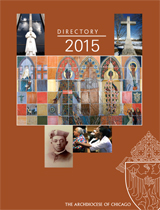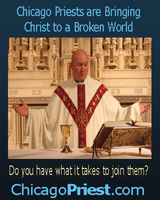Hispanic ministry program at CTU turns 25

A regular feature of The Catholic New World, The InterVIEW is an in-depth conversation with a person whose words, actions or ideas affect today's Catholic. It may be affirming of faith or confrontational. But it will always be stimulating.
Fray Gilberto Cavazos-González
leads the Hispanic ministry program at Catholic Theological Union in addition to serving as chairman of the spirituality and pastoral ministry department. The Hispanic ministry program celebrated its 25th anniversary Oct. 12 with the Mesa y Mensaje (Meal and Message) dinner. Cavazos-González, who took over the program in 2000, was there at the beginning as a student. He shared his ideas about the programs past and future with Catholic New World assistant editor Michelle Martin.
Catholic New World: How did the Hispanic ministry program start?
Fray Gilberto Cavazos-González: 1981 was when I moved here to go to school, and that year we (Latino students) really complained that we were being prepared to do ministry in a church that really is not ours. We were being prepared to minister in a suburban white middle-class parish, and the fact is that at least for the Mexican Americans and other Hispanics who were studying here, we would end up doing ministry in Mexican-American parishes or Puerto Rican parishes, some of which would be middle class and some of which would not be middle class, which would be poor parishes.
CTU’s response was to hire a professor by the name of Andres Guerrero. Andres had just written a book called “Chicano Theology.” It’s developed over the years. From the onset, the purpose was to provide courses in Hispanic ministry and Hispanic theology for the students.
I began to think it would be nice to have somebody walk away from the school with some kind of specialization in Hispanic ministry or a certificate in Hispanic ministry. The master of arts in pastoral studies now has a concentration in Hispanic studies. At Mesa y Mensaje, we will announce that starting this year, we now have a certificate in Hispanic ministry that a student can get at CTU. I’ve been working on that one for three or four years and I’m excited that it’s finally going to happen.
We will be the first Catholic school in the Midwest to offer that certificate and we are the 12th academic institution in the United States to offer a certificate in Hispanic ministry.
CNW: Who is taking these programs?
FGCG: It’s interesting how the demographics have changed. When we first asked for it, the majority of the Latino seminarians were Mexican Americans, people born here. Now the majority of the Latino seminarians are Latin Americans. They are born outside the United States. There are historical reasons the Catholic Church in the United States has a real hard time attracting U.S. born Latinos. Even demographics—there’s like 2,900 Latino priests in the United States, of which only 500 are actually born here. Historically, when the United States took over the Southwest, the Catholic Church moved in with Irish and German bishops, who closed all the Mexican seminaries and sent the seminarians home. We’re still in the aftermath of that. It’s only been 140 years, I think, since the conquest.
When you look at the numbers, supposedly there are 281 bishops in the United States. Only 25 are Hispanics. When you consider the church is about 40 percent Hispanic, the balance isn’t there.
CNW: How do you help that happen?
FGCG: We don’t have enough Hispanic priests to go around, but the U.S. Hispanic has been used to lay ministry from the very beginning. When the German and Irish church came into the Southwest and basically the Mexican was pushed to the back of the church, a lot of our posadas and certain things we’ve always liked to do, the church didn’t want to do. Our mothers and grandmothers kept doing it, so we’ve had lay ministry all along.
What we now want to do is educate that lay minister to become the prominent figure that Hispanic youth can look up to and hopefully have an interest in church ministry, which may lead to an increase of Hispanic priests, but maybe not. It may just lead to an increase of well-educated Hispanic lay ministers, which is just fine. God calls who God wants to call. Up until recently it has been the mothers and the grandmothers and the aunts who have been doing lay ministry for over 100 years in the Hispanic church.
CNW: Why is a Hispanic ministry program necessary?
FGCG: For two reasons. The number of Hispanic people who are training for ministry is lower than the number of Euro-Americans. The Euro-American church and the Hispanic church are similar but not the same. Historically, the Hispanic church is maybe 200 years older than the U.S. church. We were born at the tail end of the medieval church, whereas the U.S. church was born as a definitely Tridentine conservative church. We were born in a more liberal time period, so there are all sorts of differences between the U.S. church and the Hispanic church in this country. We might lose our Spanish, but we don’t really lose our customs, who we are. So it’s to help train Euro-Americans to work with a church that is becoming more and more Hispanic.
[The second reason] is if only 500 of the almost 3,000 Latino priests in the United States are U.S.-born, that means the rest are not, and the Hispanic church in the United States has received enough influence from the United States that we’re not like the Latin-American church anymore either. Somebody has to train the foreign-born Latinos to be able to understand the native-born. We’re different. Some of the problems of the foreign-born Latino priests could be alleviated if they were willing to take courses and learn more about the U.S. Hispanic reality.
 Catholic
New World - Newspaper for the Archdiocese of Chicago
Catholic
New World - Newspaper for the Archdiocese of Chicago Archdiocese of Chicago Directory
Archdiocese of Chicago Directory Oficjalne wydawnictwo Archidiecezji Chicago w języku polskim
Oficjalne wydawnictwo Archidiecezji Chicago w języku polskim
